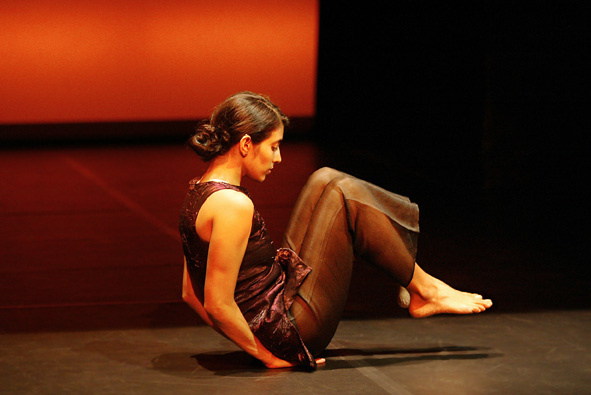
© » KADIST
Erin Jane Nelson
In Erin Jane Nelson’s 2019 body of work Av, panels are covered in collaged images and shellacked with resin or epoxy: photographs of plants intermingle with pictures of men and women engaging in various spiritual activities, cartoons of mothers and their children, or black and white images of window panes. The panels and ceramics act as backdrops upon which Nelson attempts to establish connections between the natural world and the various cultural and religious orders we impose upon it. She incorporates Jewish symbolism and archival photographs alongside her ongoing photographic practice documenting the environmental collapse of her home region.

© » KADIST
Naama Tsabar
Naama Tsabar’s sculptural works are developed serially. The series Work on Felt references the history of post-minimal sculpture: from Robert Morris to Joseph Beuys’s social sculptures. However one can equally relate her work to 1970s conceptual performers such as Terry Fox or Paul Kos.

© » KADIST
Ruth Patir
Historical representations of the female form and the clichés and misunderstandings that surround them have been the subject of recent research and historical revision. Marry, Fuck, Kill by Ruth Patir reimagines sculptures of fertility goddesses from ancient times as real-life women by animating them as a moving sculptural bodies. In a country such as Israel, where the presence of ancient ruins are common, if not everyday for some, this work speaks both to the present and the distant past, and draws continuities between.
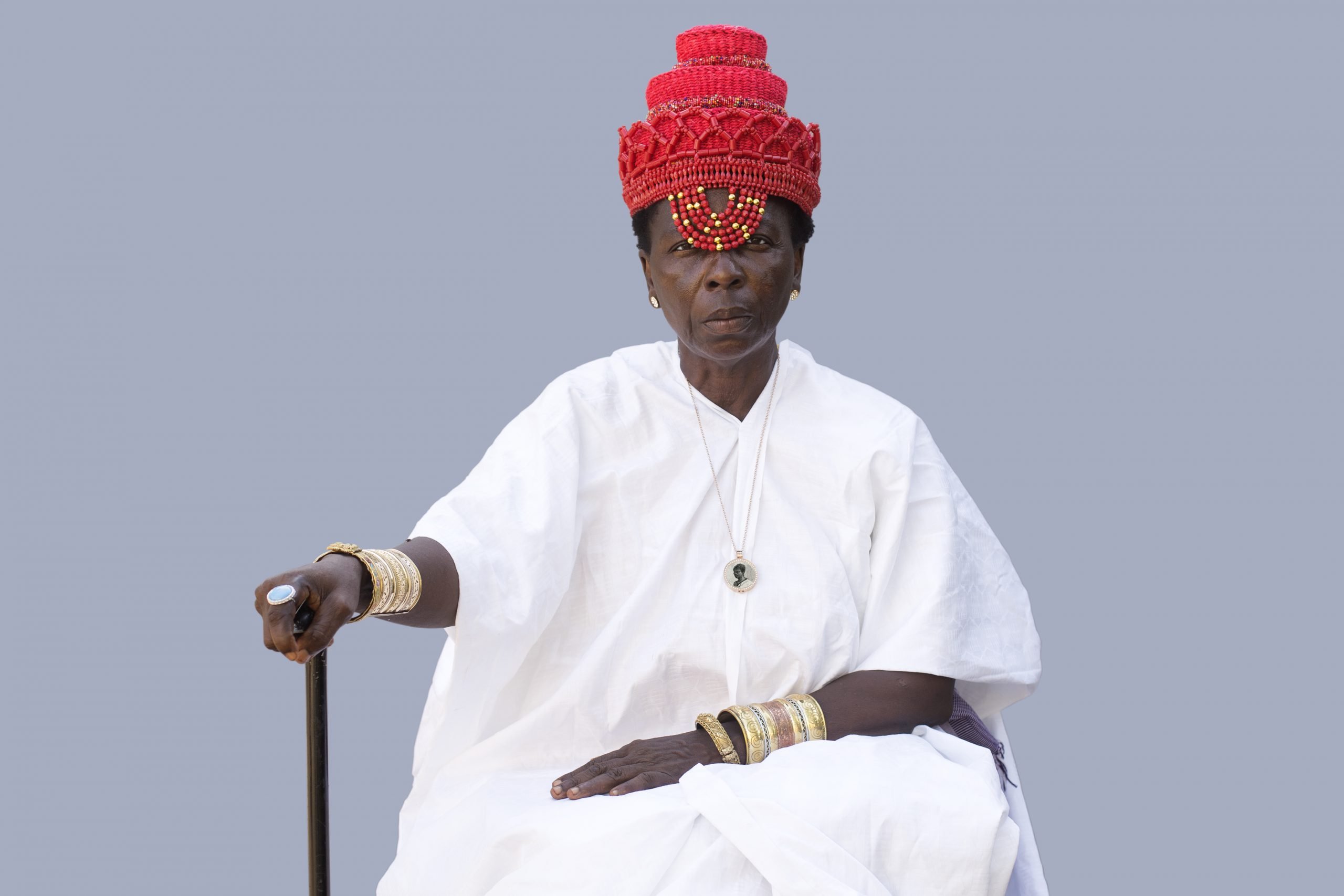
© » KADIST
Ishola Akpo
Noticing the lack of archives on the queens of various African kingdoms, artist Ishola Akpo created several series of work that retrace their history. Akpo uses different mediums in these projects, as a metaphor to the complex stories of the figures and their true political weight. One part of the project, the Agbara Women photographic series, employs fictional portraits that sheds light on the queens’ histories.

© » KADIST
Gisela McDaniel
Got Your Back by Gisela McDaniel depicts two women of color from different ethnic backgrounds who share similar violent experiences. However, the sitters never met and were depicted separately by artist Gisela McDaniel. The painting is thus an artificial construct, whose warm, gentle and seemingly benign look Is undermined by the accompanying soundtrack detailing their horrific experiences.

© » KADIST
Asli Çavusoglu
In the exhibition Pink as a Cabbage / Green as an Onion / Blue as an Orange , Asli Çavusoglu pursues her work on color to delve into an investigation into alternative agricultural systems and natural dyes made with fruits, vegetables, and plants cultivated by the farming initiatives she has been in touch with. Yet, rather than formulating the history of a particular color, the artist thinks through color, bringing together the various stories and models numerous farming initiatives in Turkey. The fabrics – each corresponding to a unique initiative – evoke the question: How have the social uprisings in Turkey during the last decade shaped the way we reimagine sites of everyday resistance?

© » KADIST
Lisetta Carmi
On New Year’s Eve in 1965, Lisette Carmi met and photographed a group of transgender people living and working on the Via del Campo in Genoa–the main street for prostitution in the city, located in the former Jewish ghetto. This encounter was the beginning of a seven year relationship with the group, and led to the publication of I Travestiti (1972), a controversial book that comprised all of the images Carmi took of the group between 1965-1971. Forming close friendships with the people she portrayed, the artist rented an attic near Via del Campo in Genoa to live with them, she captured the everyday lives of the group, depicting sex work from a new perspective.

© » KADIST
Asli Çavusoglu
In the exhibition Pink as a Cabbage / Green as an Onion / Blue as an Orange , Asli Çavusoglu pursues her work on color to delve into an investigation into alternative agricultural systems and natural dyes made with fruits, vegetables, and plants cultivated by the farming initiatives she has been in touch with. Yet, rather than formulating the history of a particular color, the artist thinks through color, bringing together the various stories and models numerous farming initiatives in Turkey. The fabrics – each corresponding to a unique initiative – evoke the question: How have the social uprisings in Turkey during the last decade shaped the way we reimagine sites of everyday resistance?

© » KADIST
Tala Madani
Madani works on a small scale and a large scale. This work is from a series of small paintings called Dazzle Men that take as their starting point the Dazzle patterns used by artists to camouflage ships during the First World War. Dazzle camouflage was designed to confuse the aim of U boat commanders.

© » KADIST
Citra Sasmita
The work Timur Merah Project 2, the harbour of restless spirit is stretched out on a full cow’s hide, replicates the Kamasan Balinese painterly language that Citra Sasmita has developed in her recent works. It represents female figures, flames, and various natural elements, permutating whimsically in a narrative of pansexual energy. While rooted in mythological thinking, with specifically Hindu and Balinese references, the scenes are equally part of a contemporary process of imagining a secular and empowered mythology for a post-patriarchal future.
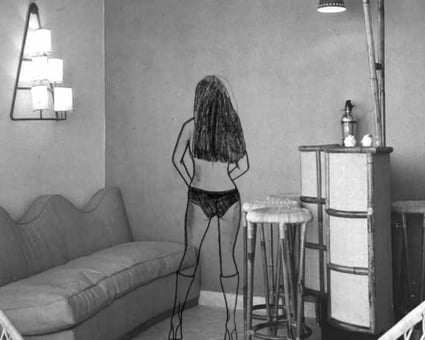
© » KADIST
Marwa Arsanios
I’ve heard stories (2008) is one of Marwa Arsanios early works. It is a short animated film staging a story that took place at the Carlton hotel in Beirut. This work is the first part of a longer project on this iconic building.
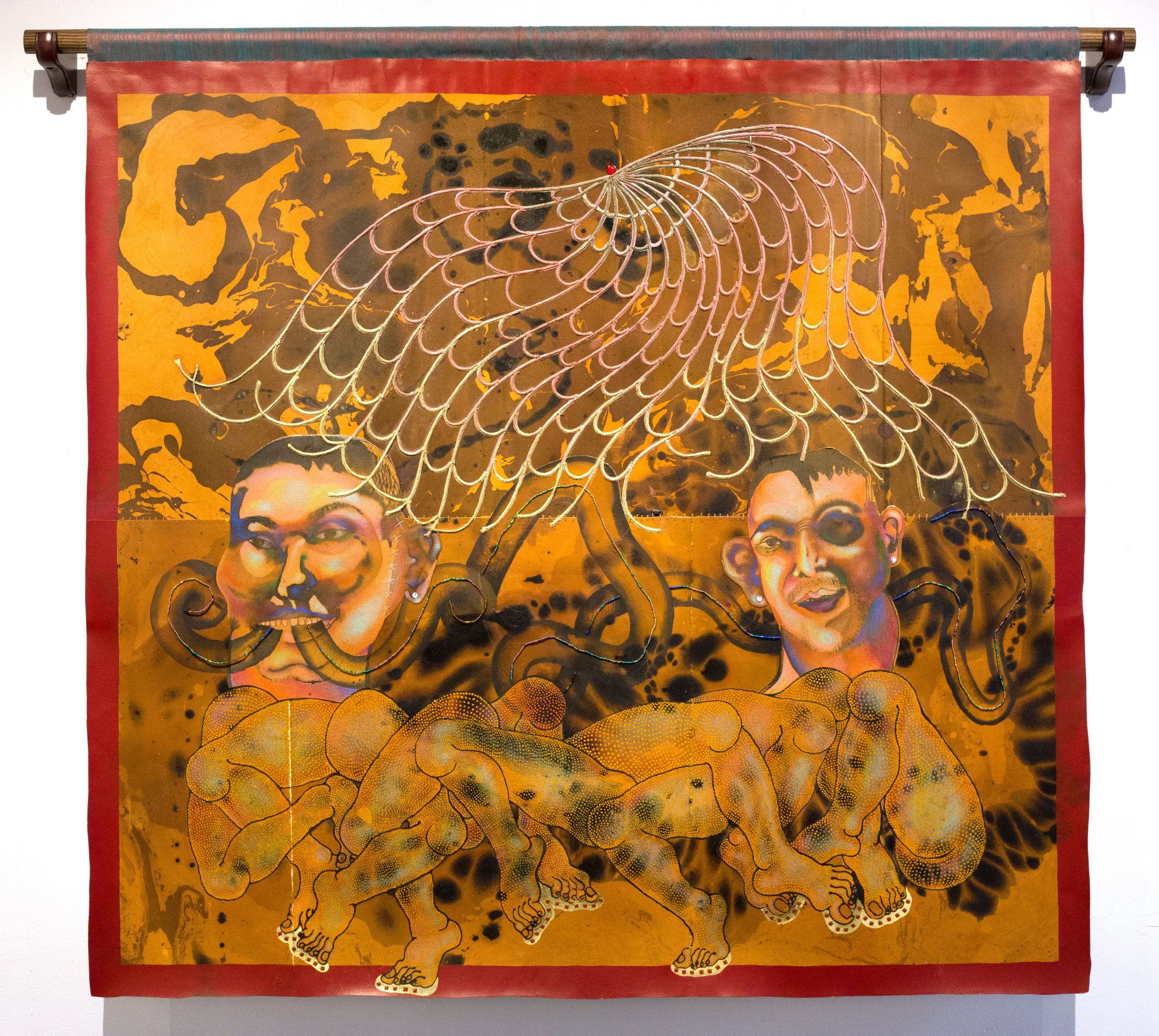
© » KADIST
Sahana Ramakrishnan
Sahana Ramakrishnan’s work blends cultural influences, spanning a range of visual mythologies, she weaves together a tapestry of pop cultural references that are upended by the artist’s exploration of identity, sexuality and gender perspectives. Narrative journeys are central to myth, and Ramakrishnan’s own journey through culture, mythology and sexuality is echoed in the physical matter she uses to create her work. The artist embarks on Odyssean quests for her materials.

© » KADIST
Judith Barry
The chapter Ayousha , of Judith Barry’s Cairo Stories , is a portrait-like work that consists of one plasma screen and one framed photograph. The project developed out of oral archives made from 215 interviews, which Barry conducted with women of varying social and economic classes in Cairo between 2003 and 2011. Her research started at the beginning of the Iraq War and concluded just after the Arab Spring.

© » KADIST
Lala Rašcic
In Greek mythology, Arachne was a talented mortal weaver who challenged Athena, goddess of wisdom and crafts, to a weaving contest; this hubris resulted in her being transformed into a spider. EE-0 is the first episode of the Europa Enterprise project which looks into new, feminist readings of established Eurocentric myths and reconsiders the meaning of cultural heritage and the production of artifacts for the future. In EE-0 , the Greek myth of Arachne is re-contextualized through a poetic script, taking an imaginative leap from antiquity into science fiction.

© » KADIST
Ana Navas
Ana Navas uses humor to address formal, aesthetic, and societal conventions that are interwoven in the everyday through the normalization of gendered behaviors and style choices used to project personal and collective signifiers. In her Donation Vases she uses quotes taken from corporate coach Lois P. Frankel’s book Nice girls (still) don’t get the corner office: Unconscious Mistakes Women Make That Sabotage Their Careers (2004). The aspirational, somewhat cynical tone of the sentences – “When given a choice, sit next to most powerful person, their power will cascade over you,” “Why is it that women buy those little chains to hang reading glasses around their necks,” “If you see your reflection on a glossy surface & notice something wrong, avoid fixing it there” – reveals a particular understanding of what a professional, ambitious cis woman should look like, the persona she should project, and the type of desirable behaviors that constitute a stereotypical “successful woman” according to a capitalist morality.

© » KADIST
Kubra Khademi
Drawing & Print (Drawing & Print)
Kubra Khademi’s work celebrates the female body and in her detailed drawings and paintings she portrays female bodies floating on white paper. Specifically she portrays the two bodies she had access to when she learned how to draw: herself and on occasion her mother. She represents women as warriors, goddesses and shameless playful heroines in search of pleasure and discovery.

© » KADIST
Kubra Khademi
Drawing & Print (Drawing & Print)
Kubra Khademi’s work celebrates the female body and in her detailed drawings and paintings she portrays female bodies floating on white paper. Specifically she portrays the two bodies she had access to when she learned how to draw: herself and on occasion her mother. She represents women as warriors, goddesses and shameless playful heroines in search of pleasure and discovery.

© » KADIST
Kubra Khademi
Drawing & Print (Drawing & Print)
Kubra Khademi’s work celebrates the female body and in her detailed drawings and paintings she portrays female bodies floating on white paper. Specifically she portrays the two bodies she had access to when she learned how to draw: herself and on occasion her mother. She represents women as warriors, goddesses and shameless playful heroines in search of pleasure and discovery.

© » KADIST
Joscelyn Gardner
Drawing & Print (Drawing & Print)
Creole Portraits III alludes to the 18th century practice by slave women on Caribbean plantations of using tropical plants as natural abortifacients. As an act of political resistance against their exploitation as “breeders” of new slaves and to protest the inhumanity of slavery, some slave women chose to either abort or kill their offspring. Armed with practical knowledge passed on orally from their African ancestors and/or Amerindian counterparts, enslaved Creole women collected the seeds, bark, flowers, sap, and roots from various plants which allowed them to secretly put an end to their pregnancies.

© » KADIST
Claudia Gutiérrez
The title for this body of work, Poco se gana hilando, pero menos mirando , is based on a Spanish saying that underestimates feminized crafts or tasks, implying that it is better for a woman to be doing ‘something’, no matter how useless it is, instead of just doing nothing. This series of works by Claudia Gutiérrez Marfull features embroideries that represent the peripheral and marginalized landscapes of Puente Alto commune in Santiago, the city’s biggest district and its most southern outskirts. In 2015, when this work was produced, there was not a single health service provider, police station, pharmacy, daycare or school in the whole area of Puente Alto.

© » KADIST
Diane Simpson
Simpson’s sculptural practice connects architecture, clothing, furniture and the body to explore the functional and sociological roles and the influence of the design and architecture of various cultures and periods in history. Her sculptures hold very specific references and are developed and transformed through revised drawings to create hybrid forms that are directed by her means of construction and choice of materials.

© » KADIST
Asli Çavusoglu
In the exhibition Pink as a Cabbage / Green as an Onion / Blue as an Orange , Asli Çavusoglu pursues her work on color to delve into an investigation into alternative agricultural systems and natural dyes made with fruits, vegetables, and plants cultivated by the farming initiatives she has been in touch with. Yet, rather than formulating the history of a particular color, the artist thinks through color, bringing together the various stories and models numerous farming initiatives in Turkey. The fabrics – each corresponding to a unique initiative – evoke the question: How have the social uprisings in Turkey during the last decade shaped the way we reimagine sites of everyday resistance?

© » KADIST
Laura Huertas Millán
La libertad is a “greca” film, a meander film, with no beginning nor end, weaving together fragments of daily life at the Navarro´s, counting threads and time, wondering and wandering around words as emancipation, labor, and freedom (la libertad), the word that most appeared in our conversations. The “greca”, the meander, is the main symbol weaved in the textiles made by the Navarro sisters, from Santo Tomás Jalieza, México. A geometrical form of an endless braid of diamonds, the “greca” represents corn, an entity worshiped by the pre-hispanic civilisations of Mesoamerica.
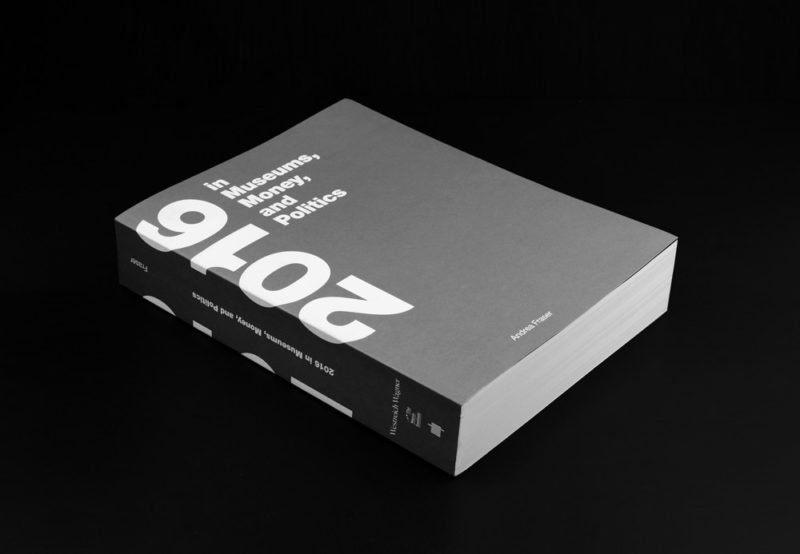
© » KADIST
Andrea Fraser
Drawing & Print (Drawing & Print)
The year 2016 is organized like a telephone book; the data corresponding to the contributions are classified in alphabetical order by the name of the donor. With this database as well as other types of information, the 900-page book presents a material representation of the scale of the cross over between cultural philanthropy and the financing of political campaigns in America. It also provides an unprecedented resource for discovering the political leaning of the museum sector.

© » KADIST
Wang Taocheng
Reflection Paper No. 2 is one of four videos in which Wang attempts to accurately illustrate the writings of influential Chinese Eileen Chang, who published her works during the Japanese occupation of China. Image and text reflect on the everyday experiences of women in society, family, marriage, love, and death.

© » KADIST
Desiree Holman
Reborn, 2010 is a three-channel video by Desiree Holman that questions ideas of motherhood and the maternal instinct. The video features a group of women as they tenderly cradle lifelike baby dolls atop their rocking chairs. Although at first, the video might appear as a celebration of the maternal bond, the scene soon becomes eerie and unsettling as we see milk spilling out of the mothers’ mouths.

© » KADIST
Clare Rojas
Rojas’s two pieces in the Kadist Collection— Untitled (four-legged…) and Untitled (Bird’s Eyes) —are representative of her pictorial style which uses bold colorful blocks of paint and female and animal characters. While Untitled (Bird’s Eyes) does not depict any actual women, it nevertheless alludes to gender roles and the power of the female gaze. Apparently playful, this scene of two animals has an ominous quality: A bird and a hedgehog confront at each other and the bird appears to be poking, even eating the hedgehog’s eye.

© » KADIST
Juliana Huxtable
Herculine’s Prophecy by Juliana Huxtable features a kneeling demon-figure on what appears to be a screen-print, placed on a wooden table, which has then been photographed and digitally altered to appear like a book cover, with a title and subtitle across the top, and a poem written across the bottom. This composition is stuck to a metal plate by a series of button magnets, with interjecting phrases on them. The juxtaposition between the mysogynistic, almost puritan poetry that stripes across the bottom and the powerful crouching pose that the femme demon assumes inverts the hegemonic text , instead creating a space of alterity.

© » KADIST
Lynn Hershman Leeson
Hershman Leeson’s documentary, Women Art Revolution (W. A. R.) draws from hundreds of hours of intimate interviews with her contemporaries—visionary artists, historians, curators and critics—who recount their fight to break down the barriers facing women both in the art world and society at large. The film features an original score by Carrie Brownstein, formerly of the band Sleater-Kinney.

© » KADIST
Clare Rojas
Rojas’s two pieces in the Kadist Collection— Untitled (four-legged…) and Untitled (Bird’s Eyes) —are representative of her pictorial style which uses bold colorful blocks of paint and female and animal characters. While Untitled (Bird’s Eyes) does not depict any actual women, it nevertheless alludes to gender roles and the power of the female gaze. Apparently playful, this scene of two animals has an ominous quality: A bird and a hedgehog confront at each other and the bird appears to be poking, even eating the hedgehog’s eye.
Kubra Khademi
Afghani artist Kubra Khademi uses her practice to explore her experiences as both a refugee and as a woman...
Clare Rojas
- location: San Francisco, California
- year born: 1976
- gender: female
- nationality: American
- home town: Columbus, Ohio
Marwa Arsanios
Marwa Arsanios is born in 1978 in Washington, United-States...
Citra Sasmita
Artist Citra Sasmita’s work is inscribed with originality in a pan-Asian effort to revisit traditional artistic languages as tools of expression in contemporary society...
Desiree Holman
- location: Oakland, California
- gender: female
- nationality: American
Wang Taocheng
Wang Taocheng is a Shanghai artist who lives and works in Amsterdam...
Diane Simpson
Diane Simpson is interested in a seamless shifting from body to architectural form in the melding of the wearable with the structural un-wearable...
Ruth Patir
Ruth Patir works with video and performances that complicate facile separations of public and private spheres...
Gisela McDaniel
Chamorro artist Gisela McDaniel depicts Native American and mixed-race women from the USA’s former, as well as current, Pacific territories...
Judy Chicago
- location: Belen, New Mexico
- year born: 1939
- gender: female
- nationality: American
- home town: Chicago, Illinois
Joscelyn Gardner
Joscelyn Gardner is a Caribbean / Canadian visual artist working primarily with printmaking and multimedia installation...
Ana Navas
Ana Navas’s practice deals with the vulgarization of modern art, understanding the term vulgar in its original sense of being appropriated by common people...
Juliana Huxtable
- location: New York, New York
- year born: 1987
- nationality: American
Naama Tsabar
Naama Tsabar is an Israel-born, New York-based sculpture artist...
Lisetta Carmi
Lisetta Carmi was born into a middle-class Jewish family in Genoa, Italy...
Ishola Akpo
Ishola Akpo is a photographer and multimedia artist whose practice explores the possibilities of digital technology...
Lynn Hershman Leeson
- location: San Francisco, California
- year born: 1941
- gender: female
- nationality: American
- home town: Cleveland, Ohio
Andrea Fraser
- location: Montana, United States
- year born: 1965
- gender: female
- nationality: American
Tala Madani
Madani’s paintings have a caricatural quality that suggest a satirical intention...
Judith Barry
The American artist, writer, and educator Judith Barry is known for her audiovisual installations and her critical essays...
Sahana Ramakrishnan
Sahana Ramakrishnan creates images that are complicated, dissonant, and abject in ways that open the heart and mind...
Erin Jane Nelson
Artist Erin Jane Nelson’s practice is grounded in photography sourced from her personal archive of found and original images...
-
1960-1969
Lisetta Carmi
1969On New Year’s Eve in 1965, Lisette Carmi met and photographed a group of transgender people living and working on the Via del Campo in Genoa–the main street for prostitution in the city, located in the former Jewish ghetto...
Judy Chicago
1969Domes #1 represents a significant moment in Chicago’s career when her art began to change from a New York-influenced Abstract Expressionist style to one that reflected the pop-inflected art being made in Los Angeles...
-
2000-2009
Clare Rojas
2006Rojas’s two pieces in the Kadist Collection— Untitled (four-legged…) and Untitled (Bird’s Eyes) —are representative of her pictorial style which uses bold colorful blocks of paint and female and animal characters...
Clare Rojas
2008Rojas’s two pieces in the Kadist Collection— Untitled (four-legged…) and Untitled (Bird’s Eyes) —are representative of her pictorial style which uses bold colorful blocks of paint and female and animal characters...
Joscelyn Gardner
Drawing & Print
2009(Drawing & Print) Creole Portraits III alludes to the 18th century practice by slave women on Caribbean plantations of using tropical plants as natural abortifacients...
-
2010-2019
Desiree Holman
2010Reborn, 2010 is a three-channel video by Desiree Holman that questions ideas of motherhood and the maternal instinct...
Diane Simpson
2012Simpson’s sculptural practice connects architecture, clothing, furniture and the body to explore the functional and sociological roles and the influence of the design and architecture of various cultures and periods in history...
Claudia Gutiérrez
2016The title for this body of work, Poco se gana hilando, pero menos mirando , is based on a Spanish saying that underestimates feminized crafts or tasks, implying that it is better for a woman to be doing ‘something’, no matter how useless it is, instead of just doing nothing...
Laura Huertas Millán
2016La libertad is a “greca” film, a meander film, with no beginning nor end, weaving together fragments of daily life at the Navarro´s, counting threads and time, wondering and wandering around words as emancipation, labor, and freedom (la libertad), the word that most appeared in our conversations...
Juliana Huxtable
2017Herculine’s Prophecy by Juliana Huxtable features a kneeling demon-figure on what appears to be a screen-print, placed on a wooden table, which has then been photographed and digitally altered to appear like a book cover, with a title and subtitle across the top, and a poem written across the bottom...
Lala Rašcic
2018In Greek mythology, Arachne was a talented mortal weaver who challenged Athena, goddess of wisdom and crafts, to a weaving contest; this hubris resulted in her being transformed into a spider...
Erin Jane Nelson
2019In Erin Jane Nelson’s 2019 body of work Av, panels are covered in collaged images and shellacked with resin or epoxy: photographs of plants intermingle with pictures of men and women engaging in various spiritual activities, cartoons of mothers and their children, or black and white images of window panes...
Ruth Patir
2019Historical representations of the female form and the clichés and misunderstandings that surround them have been the subject of recent research and historical revision...
Citra Sasmita
2019The work Timur Merah Project 2, the harbour of restless spirit is stretched out on a full cow’s hide, replicates the Kamasan Balinese painterly language that Citra Sasmita has developed in her recent works...
Sahana Ramakrishnan
2019Sahana Ramakrishnan’s work blends cultural influences, spanning a range of visual mythologies, she weaves together a tapestry of pop cultural references that are upended by the artist’s exploration of identity, sexuality and gender perspectives...
-
2020-2029
Gisela McDaniel
2020Got Your Back by Gisela McDaniel depicts two women of color from different ethnic backgrounds who share similar violent experiences...
Asli Çavusoglu
2020In the exhibition Pink as a Cabbage / Green as an Onion / Blue as an Orange , Asli Çavusoglu pursues her work on color to delve into an investigation into alternative agricultural systems and natural dyes made with fruits, vegetables, and plants cultivated by the farming initiatives she has been in touch with...
Asli Çavusoglu
2020In the exhibition Pink as a Cabbage / Green as an Onion / Blue as an Orange , Asli Çavusoglu pursues her work on color to delve into an investigation into alternative agricultural systems and natural dyes made with fruits, vegetables, and plants cultivated by the farming initiatives she has been in touch with...
Kubra Khademi
Drawing & Print
2020(Drawing & Print) Kubra Khademi’s work celebrates the female body and in her detailed drawings and paintings she portrays female bodies floating on white paper...
Kubra Khademi
Drawing & Print
2020(Drawing & Print) Kubra Khademi’s work celebrates the female body and in her detailed drawings and paintings she portrays female bodies floating on white paper...
Kubra Khademi
Drawing & Print
2020(Drawing & Print) Kubra Khademi’s work celebrates the female body and in her detailed drawings and paintings she portrays female bodies floating on white paper...
Asli Çavusoglu
2020In the exhibition Pink as a Cabbage / Green as an Onion / Blue as an Orange , Asli Çavusoglu pursues her work on color to delve into an investigation into alternative agricultural systems and natural dyes made with fruits, vegetables, and plants cultivated by the farming initiatives she has been in touch with...
Andrea Fraser
Drawing & Print
2020(Drawing & Print) The year 2016 is organized like a telephone book; the data corresponding to the contributions are classified in alphabetical order by the name of the donor...
Ishola Akpo
2021Noticing the lack of archives on the queens of various African kingdoms, artist Ishola Akpo created several series of work that retrace their history...























